Paths — SVG 2 (original) (raw)
Chapter 9: Paths
Contents
- 9.1. Introduction
- 9.2. The ‘path’ element
- 9.3. Path data
- 9.3.1. General information about path data
- 9.3.2. Specifying path data: the ‘d’ property
- 9.3.3. The "moveto" commands
- 9.3.4. The "closepath" command
1. 9.3.4.1. Segment-completing close path operation - 9.3.5. The "lineto" commands
- 9.3.6. The cubic Bézier curve commands
- 9.3.7. The quadratic Bézier curve commands
- 9.3.8. The elliptical arc curve commands
- 9.3.9. The grammar for path data
- 9.4. Path directionality
- 9.5. Implementation notes
- 9.6. Distance along a path
- 9.7. DOM interfaces
9.1. Introduction
A path represents the outline of a shape which can be filled or stroked. A path can also be used as a clipping path, to describe animation, or position text. A path can be used for more than one of these functions at the same time. (SeeFilling, Stroking and Paint Servers,Clipping and Masking, Animation ('animateMotion'), and Text on a Path.)
A path is described using the concept of a current point. In an analogy with drawing on paper, the current point can be thought of as the location of the pen. The position of the pen can be changed, and the outline of a shape (open or closed) can be traced by dragging the pen in either straight lines or curves.
Paths represent the geometry of the outline of an object, defined in terms of moveto (set a new current point),lineto (draw a straight line), curveto (draw a curve using a cubic Bézier), arc (elliptical or circular arc) and closepath (close the current shape by connecting to the last moveto) commands. Compound paths (i.e., a path with multiple subpaths) are possible to allow effects such as "donut holes" in objects.
This chapter describes the syntax, behavior and DOM interfaces for SVG paths. Various implementation notes for SVG paths can be found in ‘path’ element implementation Notes.
A path is defined in SVG using the ‘path’ element.
The basic shapes are all described in terms of what theirequivalent path is, which is what their shape is as a path. (The equivalent path of a‘path’ element is simply the path itself.) In order to define the basic shapes as equivalent paths, a segment-completing close path operation is defined, which cannot currently be represented in the basic path syntax.
9.2. The ‘path’ element
‘path’
Categories:
Graphics element, renderable element, shape element
Content model:
Any number of the following elements, in any order:
- animation elements — ‘animate’, ‘animateMotion’, ‘animateTransform’, ‘discard’, ‘set’
- descriptive elements — ‘desc’, ‘title’, ‘metadata’
- paint server elements — ‘linearGradient’, ‘radialGradient’, ‘pattern’ clipPath, marker, mask, script, style
Attributes:
- aria attributes — ‘aria-activedescendant’, ‘aria-atomic’, ‘aria-autocomplete’, ‘aria-busy’, ‘aria-checked’, ‘aria-colcount’, ‘aria-colindex’, ‘aria-colspan’, ‘aria-controls’, ‘aria-current’, ‘aria-describedby’, ‘aria-details’, ‘aria-disabled’, ‘aria-dropeffect’, ‘aria-errormessage’, ‘aria-expanded’, ‘aria-flowto’, ‘aria-grabbed’, ‘aria-haspopup’, ‘aria-hidden’, ‘aria-invalid’, ‘aria-keyshortcuts’, ‘aria-label’, ‘aria-labelledby’, ‘aria-level’, ‘aria-live’, ‘aria-modal’, ‘aria-multiline’, ‘aria-multiselectable’, ‘aria-orientation’, ‘aria-owns’, ‘aria-placeholder’, ‘aria-posinset’, ‘aria-pressed’, ‘aria-readonly’, ‘aria-relevant’, ‘aria-required’, ‘aria-roledescription’, ‘aria-rowcount’, ‘aria-rowindex’, ‘aria-rowspan’, ‘aria-selected’, ‘aria-setsize’, ‘aria-sort’, ‘aria-valuemax’, ‘aria-valuemin’, ‘aria-valuenow’, ‘aria-valuetext’, ‘role’
- conditional processing attributes — ‘requiredExtensions’, ‘systemLanguage’
- core attributes — ‘id’, ‘tabindex’, ‘lang’, ‘xml:space’, ‘class’, ‘style’
- global event attributes — ‘oncancel’, ‘oncanplay’, ‘oncanplaythrough’, ‘onchange’, ‘onclick’, ‘onclose’, ‘oncuechange’, ‘ondblclick’, ‘ondrag’, ‘ondragend’, ‘ondragenter’, ‘ondragexit’, ‘ondragleave’, ‘ondragover’, ‘ondragstart’, ‘ondrop’, ‘ondurationchange’, ‘onemptied’, ‘onended’, ‘onerror’, ‘onfocus’, ‘oninput’, ‘oninvalid’, ‘onkeydown’, ‘onkeypress’, ‘onkeyup’, ‘onload’, ‘onloadeddata’, ‘onloadedmetadata’, ‘onloadstart’, ‘onmousedown’, ‘onmouseenter’, ‘onmouseleave’, ‘onmousemove’, ‘onmouseout’, ‘onmouseover’, ‘onmouseup’, ‘onmousewheel’, ‘onpause’, ‘onplay’, ‘onplaying’, ‘onprogress’, ‘onratechange’, ‘onreset’, ‘onresize’, ‘onscroll’, ‘onseeked’, ‘onseeking’, ‘onselect’, ‘onshow’, ‘onstalled’, ‘onsubmit’, ‘onsuspend’, ‘ontimeupdate’, ‘ontoggle’, ‘onvolumechange’, ‘onwaiting’
- document element event attributes — ‘oncopy’, ‘oncut’, ‘onpaste’
- graphical event attributes — ‘onfocusin’, ‘onfocusout’
- presentation attributes —
- ‘pathLength’
Geometry properties:
DOM Interfaces:
The outline of a shape for a ‘path’ element is specified using the dproperty. See Path data below.
9.3. Path data
9.3.1. General information about path data
A path is defined by including a ‘path’element on which the d property specifies the path data. The path data contains the_moveto_, lineto, curveto (both cubic and quadratic Béziers), arc and _closepath_instructions.
Example triangle01specifies a path in the shape of a triangle. (TheM indicates a moveto, theLs indicate _lineto_s, and thez indicates a closepath).
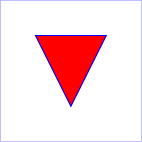
Example triangle01
View this example as SVG (SVG-enabled browsers only)
Path data can contain newline characters and thus can be broken up into multiple lines to improve readability. Newlines inside attributes in markup will be normalized to space characters while parsing.
The syntax of path data is concise in order to allow for minimal file size and efficient downloads, since many SVG files will be dominated by their path data. Some of the ways that SVG attempts to minimize the size of path data are as follows:
- All instructions are expressed as one character (e.g., a_moveto_ is expressed as an M).
- Superfluous white space and separators (such as commas) may be eliminated; for instance, the following contains unnecessary spaces:
M 100 100 L 200 200
It may be expressed more compactly as:M100 100L200 200 - A command letter may be eliminated if an identical command letter would otherwise precede it; for instance, the following contains an unnecessary second "L" command:
M 100 200 L 200 100 L -100 -200
It may be expressed more compactly as:M 100 200 L 200 100 -100 -200 - For most commands there are absolute and relative versions available (uppercase means absolute coordinates, lowercase means relative coordinates).
- Alternate forms of lineto are available to optimize the special cases of horizontal and vertical lines (absolute and relative).
- Alternate forms of curve are available to optimize the special cases where some of the control points on the current segment can be determined automatically from the control points on the previous segment.
The path data syntax is a prefix notation (i.e., commands followed by parameters). The only allowable decimal point is a Unicode U+0046 FULL STOP (".") character (also referred to in Unicode as PERIOD, dot and decimal point) and no other delimiter characters are allowed [UNICODE]. (For example, the following is an invalid numeric value in a path data stream: "13,000.56". Instead, say: "13000.56".)
For the relative versions of the commands, all coordinate values are relative to the current point at the start of the command.
In the tables below, the following notation is used to describe the syntax of a given path command:
- (): grouping of parameters
- +: 1 or more of the given parameter(s) is required
In the description of the path commands, cpx andcpy represent the coordinates of the current point.
9.3.2. Specifying path data: the ‘d’ property
| Name: | d |
|---|---|
| Value: | none | |
| Initial: | none |
| Applies to: | ‘path’ |
| Inherited: | no |
| Percentages: | N/A |
| Media: | visual |
| Computed value: | as specified |
| Animatable: | yes |
The d property is used to specify the shape of a ‘path’ element.
The value none indicates that there is no path data for the element. For ‘path’ elements, this means that the element does not render or contribute to the bounding box of ancestorcontainer elements.
A path is made up of multiple segments, and every command, either explicit or implicit, other than moveto or closepath, defines one path segment.
All coordinates and lengths specified within path data must be treated as being in user units in the current user coordinate system.
The value specifies a shape using a path data string. The contents of the value must match the svg-path EBNF grammar defined below, and errors within the string are handled according to the rules in the Path Data Error Handling section. If the path data string contains no valid commands, then the behavior is the same as the none value.
For animation, two d property values can only be interpolated smoothly when the path data strings contain have the same structure, (i.e. exactly the same number and types of path data commands which are in the same order). If an animation is specified and the lists of path data commands do not have the same structure, then the values must beinterpolated using thediscrete animation type.
If the list of path data commands have the same structure, then each parameter to each path data command must beinterpolated separately as real numbers. Flags and booleans must be interpolated as fractions between zero and one, with any non-zero value considered to be a value of one/true.
Resolved that "d will become a presentation attribute (no name change) with path data string as value" atLondon Editor's Meeting.
The following sections list the commands that canbe used in path data strings. Those that draw straight line segments include the lineto commands(L, l,H, h, V and v) and the close path commands(Z and z). These three groups of commands draw curves:
- Cubic Bézier commands (C,c, S ands). A cubic Bézier segment is defined by a start point, an end point, and two control points.
- Quadratic Bézier commands (Q,q, T andt). A quadratic Bézier segment is defined by a start point, an end point, and one control point.
- Elliptical arc commands (A and a). An elliptical arc segment draws a segment of an ellipse.
9.3.3. The "moveto" commands
The "moveto" commands (M orm) must establish a new initial pointand a new current point. The effect is as if the "pen" were lifted and moved to a new location. A path data segment (if there is one) must begin with a "moveto" command. Subsequent "moveto" commands (i.e., when the "moveto" is not the first command) represent the start of a new_subpath_:
| Command | Name | Parameters | Description |
|---|---|---|---|
| M (absolute) m (relative) | moveto | (x y)+ | Start a new sub-path at the given (x,y) coordinates.M (uppercase) indicates that absolute coordinates will follow; m (lowercase) indicates that relative coordinates will follow. If a moveto is followed by multiple pairs of coordinates, the subsequent pairs are treated as implicit lineto commands. Hence, implicit lineto commands will be relative if the moveto is relative, and absolute if the moveto is absolute. If a relative moveto (m) appears as the first element of the path, then it is treated as a pair of absolute coordinates. In this case, subsequent pairs of coordinates are treated as relative even though the initial moveto is interpreted as an absolute moveto. |
When a relative m command is used, the position moved to is (cpx + x,cpy + y).
9.3.4. The "closepath" command
The "closepath" (Z or z) ends the current subpath by connecting it back to its initial point. An automatic straight line is drawn from the current point to the initial point of the current subpath. This path segment may be of zero length.
If a "closepath" is followed immediately by a "moveto", then the "moveto" identifies the start point of the next subpath. If a "closepath" is followed immediately by any other command, then the next subpath starts at the same initial point as the current subpath.
When a subpath ends in a "closepath," it differs in behavior from what happens when "manually" closing a subpath via a "lineto" command in how ‘stroke-linejoin’ and ‘stroke-linecap’ are implemented. With "closepath", the end of the final segment of the subpath is "joined" with the start of the initial segment of the subpath using the current value of ‘stroke-linejoin’. If you instead "manually" close the subpath via a "lineto" command, the start of the first segment and the end of the last segment are not joined but instead are each capped using the current value of ‘stroke-linecap’. At the end of the command, the new current point is set to the initial point of the current subpath.
| Command | Name | Parameters | Description |
|---|---|---|---|
| Z or z | closepath | (none) | Close the current subpath by connecting it back to the current subpath's initial point (see prose above). Since theZ and z commands take no parameters, they have an identical effect. |
A closed subpath must be closed with a "closepath" command, this "joins" the first and last path segments. Any other path is an open subpath.
A closed subpath differs in behavior from an open subpath whose final coordinate is the initial pointof the subpath. The first and last path segments of an open subpath will not be joined, even when the final coordinate of the last path segment is theinitial point of the subpath. This will result in the first and lastpath segments being capped using the current value of stroke-linecaprather than joined using the current value of stroke-linejoin.
If a "closepath" is followed immediately by a "moveto", then the "moveto" identifies the start point of the next subpath. If a "closepath" is followed immediately by any other command, then the next subpath must start at the same initial pointas the current subpath.
9.3.4.1. Segment-completing close path operation
In order to represent the basic shapes as equivalent paths, there must be a way to close curved shapes without introducing an additional straight-line segment (even if that segment would have zero length). For that purpose, a segment-completing close path operation is defined here.
A segment-completing close path operation combines with the previous path command, with two effects:
- It ensures that the final coordinate point of the previous command exactly matches the initial point of the current subpath.
- It joins the final and initial points of the subpath, making it a closed subpath.
Segment-completing close path operations are not currently supported as a command in the path data syntax. The working group has proposed such a syntax for future versions of the specification.
9.3.5. The "lineto" commands
The various "lineto" commands draw straight lines from the current point to a new point:
| Command | Name | Parameters | Description |
|---|---|---|---|
| L (absolute) l (relative) | lineto | (x y)+ | Draw a line from the current point to the given (x,y) coordinate which becomes the new current point.L (uppercase) indicates that absolute coordinates will follow; l (lowercase) indicates that relative coordinates will follow. A number of coordinates pairs may be specified to draw a polyline. At the end of the command, the new current point is set to the final set of coordinates provided. |
| H (absolute) h (relative) | horizontal lineto | x+ | Draws a horizontal line from the current point.H (uppercase) indicates that absolute coordinates will follow; h (lowercase) indicates that relative coordinates will follow. Multiple x values can be provided (although usually this doesn't make sense). An H or h command is equivalent to an L or l command with 0 specified for the y coordinate. At the end of the command, the new current point is taken from the final coordinate value. |
| V (absolute) v (relative) | vertical lineto | y+ | Draws a vertical line from the current point.V (uppercase) indicates that absolute coordinates will follow; v (lowercase) indicates that relative coordinates will follow. Multiple y values can be provided (although usually this doesn't make sense). A V or v command is equivalent to an L or l command with 0 specified for the x coordinate. At the end of the command, the new current point is taken from the final coordinate value. |
When a relative l command is used, the end point of the line is (cpx + x,cpy + y).
When a relative h command is used, the end point of the line is (cpx + x,cpy). This means that an h command with a positive xvalue draws a horizontal line in the direction of the positive x-axis.
When a relative v command is used, the end point of the line is (cpx,cpy + y).
9.3.6. The cubic Bézier curve commands
The cubic Bézier commands are as follows:
| Command | Name | Parameters | Description |
|---|---|---|---|
| C (absolute) c (relative) | curveto | (x1 y1 x2 y2 x y)+ | Draws a cubic Bézier curve from the current point to (x,y) using (x1,y1) as the control point at the beginning of the curve and (x2,y2) as the control point at the end of the curve. C (uppercase) indicates that absolute coordinates will follow;c (lowercase) indicates that relative coordinates will follow. Multiple sets of coordinates may be specified to draw a polybézier. At the end of the command, the new current point becomes the final (x,y) coordinate pair used in the polybézier. |
| S (absolute) s (relative) | shorthand/smooth curveto | (x2 y2 x y)+ | Draws a cubic Bézier curve from the current point to (x,y). The first control point is assumed to be the reflection of the second control point on the previous command relative to the current point. (If there is no previous command or if the previous command was not an C, c, S or s, assume the first control point is coincident with the current point.) (x2,y2) is the second control point (i.e., the control point at the end of the curve).S (uppercase) indicates that absolute coordinates will follow; s (lowercase) indicates that relative coordinates will follow. Multiple sets of coordinates may be specified to draw a polybézier. At the end of the command, the new current point becomes the final (x,y) coordinate pair used in the polybézier. |
When a relative c or scommand is used, each of the relative coordinate pairs is computed as for those in an m command. For example, the final control point of the curve of both commands is (cpx + x,cpy + y).
Example cubic01 shows some simple uses of cubic Bézier commands within a path. The example uses an internal CSS style sheet to assign styling properties. Note that the control point for the "S" command is computed automatically as the reflection of the control point for the previous "C" command relative to the start point of the "S" command.
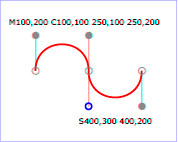
Example cubic01
View this example as SVG (SVG-enabled browsers only)
The following picture shows some how cubic Bézier curves change their shape depending on the position of the control points. The first five examples illustrate a single cubic Bézier path segment. The example at the lower right shows a "C" command followed by an "S" command.
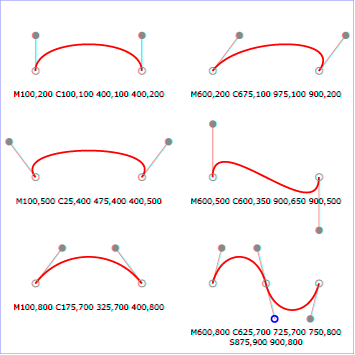
View this example as SVG (SVG-enabled browsers only)
9.3.7. The quadratic Bézier curve commands
The quadratic Bézier commands are as follows:
| Command | Name | Parameters | Description |
|---|---|---|---|
| Q (absolute) q (relative) | quadratic Bézier curveto | (x1 y1 x y)+ | Draws a quadratic Bézier curve from the current point to (x,y) using (x1,y1) as the control point.Q (uppercase) indicates that absolute coordinates will follow; q (lowercase) indicates that relative coordinates will follow. Multiple sets of coordinates may be specified to draw a polybézier. At the end of the command, the new current point becomes the final (x,y) coordinate pair used in the polybézier. |
| T (absolute) t (relative) | Shorthand/smooth quadratic Bézier curveto | (x y)+ | Draws a quadratic Bézier curve from the current point to (x,y). The control point is assumed to be the reflection of the control point on the previous command relative to the current point. (If there is no previous command or if the previous command was not a Q, q, T or t, assume the control point is coincident with the current point.) T (uppercase) indicates that absolute coordinates will follow; t (lowercase) indicates that relative coordinates will follow. At the end of the command, the new current point becomes the final (x,y) coordinate pair used in the polybézier. |
When a relative q or tcommand is used, each of the relative coordinate pairs is computed as for those in an m command. For example, the final control point of the curve of both commands is (cpx + x,cpy + y).
Example quad01 shows some simple uses of quadratic Bézier commands within a path. Note that the control point for the "T" command is computed automatically as the reflection of the control point for the previous "Q" command relative to the start point of the "T" command.
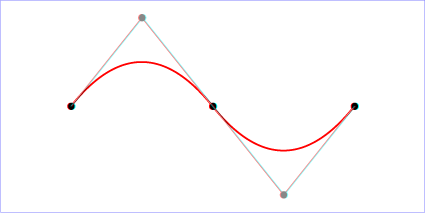
Example quad01
View this example as SVG (SVG-enabled browsers only)
9.3.8. The elliptical arc curve commands
| SVG 2 Requirement: | Make it simpler to draw arcs in SVG path syntax. |
|---|---|
| Resolution: | Make arcs in paths easier. |
| Purpose: | To make it easier for authors to write path data with arcs by hand. |
| Owner: | Cameron (ACTION-3151) |
The elliptical arc commands are as follows:
| Command | Name | Parameters | Description |
|---|---|---|---|
| A (absolute) a (relative) | elliptical arc | (rx ry x-axis-rotation large-arc-flag sweep-flag x y)+ | Draws an elliptical arc from the current point to (x, y). The size and orientation of the ellipse are defined by two radii (rx, ry) and anx-axis-rotation, which indicates how the ellipse as a whole is rotated, in degrees, relative to the current coordinate system. The center (cx,cy) of the ellipse is calculated automatically to satisfy the constraints imposed by the other parameters. large-arc-flag andsweep-flag contribute to the automatic calculations and help determine how the arc is drawn. |
When a relative a command is used, the end point of the arc is (cpx + x,cpy + y).
Example arcs01 shows some simple uses of arc commands within a path.
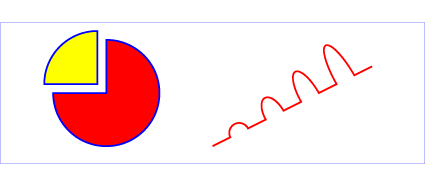
Example arcs01
View this example as SVG (SVG-enabled browsers only)
The elliptical arc command draws a section of an ellipse which must meet the following constraints:
- the arc starts at the current point
- the arc ends at point (x,y)
- the ellipse has the two radii (rx,ry)
- the x-axis of the ellipse is rotated byx-axis-rotation degrees relative to the x-axis of the current coordinate system.
For most situations, there are actually four different arcs (two different ellipses, each with two different arc sweeps) that satisfy these constraints. large-arc-flagand sweep-flag indicate which one of the four arcs are drawn, as follows:
- Of the four candidate arc sweeps, two will represent an arc sweep of greater than or equal to 180 degrees (the "large-arc"), and two will represent an arc sweep of less than or equal to 180 degrees (the "small-arc"). Iflarge-arc-flag is '1', then one of the two larger arc sweeps will be chosen; otherwise, iflarge-arc-flag is '0', one of the smaller arc sweeps will be chosen,
- If sweep-flag is '1', then the arc will be drawn in a "positive-angle" direction (i.e., the ellipse formula x=cx+rx*cos(theta) and y=cy+ry*sin(theta) is evaluated such that theta starts at an angle corresponding to the current point and increases positively until the arc reaches (x,y)). A value of 0 causes the arc to be drawn in a "negative-angle" direction (i.e., theta starts at an angle value corresponding to the current point and decreases until the arc reaches (x,y)).
The following illustrates the four combinations oflarge-arc-flag and sweep-flagand the four different arcs that will be drawn based on the values of these flags. For each case, the following path data command was used:
where "?,?" is replaced by "0,0" "0,1" "1,0" and "1,1" to generate the four possible cases.
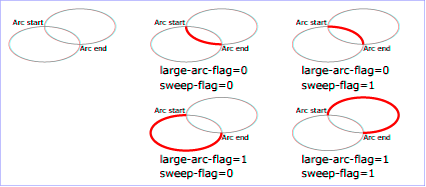
View this example as SVG (SVG-enabled browsers only)
Refer to the section on Out-of-range elliptical arc parametersfor detailed implementation notes for the path data elliptical arc commands.
The Implementation Notes appendixhas relevant formulae for software that needs to convert SVG arc notation to a format that uses center points and arc sweeps.
9.3.9. The grammar for path data
SVG path data matches the following EBNF grammar.
svg_path::= wsp* moveto? (moveto drawto_command*)?
drawto_command::= moveto | closepath | lineto | horizontal_lineto | vertical_lineto | curveto | smooth_curveto | quadratic_bezier_curveto | smooth_quadratic_bezier_curveto | elliptical_arc
moveto::= ( "M" | "m" ) wsp* coordinate_pair_sequence
closepath::= ("Z" | "z")
lineto::= ("L"|"l") wsp* coordinate_pair_sequence
horizontal_lineto::= ("H"|"h") wsp* coordinate_sequence
vertical_lineto::= ("V"|"v") wsp* coordinate_sequence
curveto::= ("C"|"c") wsp* curveto_coordinate_sequence
curveto_coordinate_sequence::= coordinate_pair_triplet | (coordinate_pair_triplet comma_wsp? curveto_coordinate_sequence)
smooth_curveto::= ("S"|"s") wsp* smooth_curveto_coordinate_sequence
smooth_curveto_coordinate_sequence::= coordinate_pair_double | (coordinate_pair_double comma_wsp? smooth_curveto_coordinate_sequence)
quadratic_bezier_curveto::= ("Q"|"q") wsp* quadratic_bezier_curveto_coordinate_sequence
quadratic_bezier_curveto_coordinate_sequence::= coordinate_pair_double | (coordinate_pair_double comma_wsp? quadratic_bezier_curveto_coordinate_sequence)
smooth_quadratic_bezier_curveto::= ("T"|"t") wsp* coordinate_pair_sequence
elliptical_arc::= ( "A" | "a" ) wsp* elliptical_arc_argument_sequence
elliptical_arc_argument_sequence::= elliptical_arc_argument | (elliptical_arc_argument comma_wsp? elliptical_arc_argument_sequence)
elliptical_arc_argument::= number comma_wsp? number comma_wsp? number comma_wsp flag comma_wsp? flag comma_wsp? coordinate_pair
coordinate_pair_double::= coordinate_pair comma_wsp? coordinate_pair
coordinate_pair_triplet::= coordinate_pair comma_wsp? coordinate_pair comma_wsp? coordinate_pair
coordinate_pair_sequence::= coordinate_pair | (coordinate_pair comma_wsp? coordinate_pair_sequence)
coordinate_sequence::= coordinate | (coordinate comma_wsp? coordinate_sequence)
coordinate_pair::= coordinate comma_wsp? coordinate
coordinate::= sign? number
sign::= "+"|"-" number ::= ([0-9])+ flag::=("0"|"1") comma_wsp::=(wsp+ ","? wsp*) | ("," wsp*) wsp ::= (#x9 | #x20 | #xA | #xC | #xD)
The processing of the EBNF must consume as much of a given EBNF production as possible, stopping at the point when a character is encountered which no longer satisfies the production. Thus, in the string "M 100-200", the first coordinate for the "moveto" consumes the characters "100" and stops upon encountering the minus sign because the minus sign cannot follow a digit in the production of a "coordinate". The result is that the first coordinate will be "100" and the second coordinate will be "-200".
Similarly, for the string "M 0.6.5", the first coordinate of the "moveto" consumes the characters "0.6" and stops upon encountering the second decimal point because the production of a "coordinate" only allows one decimal point. The result is that the first coordinate will be "0.6" and the second coordinate will be ".5".
Note that the EBNF allows the path data string in thed property to be empty. This is not an error, instead it disables rendering of the path. Rendering is also disabled when the d property has the value none.
If path data not matching the grammar is encountered, then the path data is in error (see Error Handling).
9.4. Path directionality
Some features, such as the orientationof markers and the shapes ofline caps, are defined in terms of the direction of the path at a given distance along the path or at the start or end of an individual segment.
The direction of a path at a specified distance along the path is defined as follows:
- If the given distance is zero, then the direction of the path is the direction at the start of the path's first segment.
- Otherwise, if the given distance is the length of the path, then the direction of the path is thedirection at the end of the path's last segment.
- Otherwise, if the given distance along the path occurs at a path segment boundary, then the direction of the path is thedirection at the start of the segment at the given distance, considering each segment to be endpoint exclusive.
This will "move past" zero length segments, and choose the later segment if the distance is at the boundary between two non-zero length segments.
The default direction at segment boundaries is overriden when calculating a cap shape and when rendering markers. - Otherwise, the given distance along the path occurs in the middle of a non-zero length path segment. The direction is simply the direction of the curve at that point. If the point lies at a discontinuity, such as a cusp in a Bézier segment, then the direction is undefined; in this case, a direction between the incoming and outgoing direction around the discontinuity should be used.
The direction at the start of a path segment is defined as follows:
- If length of the entire path the segment belongs to is zero, then the direction at the start of the segment points in the same direction as the positive x-axis.
- Otherwise, if the path segment is zero length and the segment does not have any preceding non-zero length segments, then the direction at the start of the segment is the same as thedirection at the end of the segment.
- Otherwise, if the path segment is zero length and there is some non-zero length segment preceding this segment, then the direction at the start of this segment is the same as thedirection at the end of the closest preceding non-zero length segment.
- Otherwise, the path segment is non-zero length. The direction at the start of the segment is simply the direction coming out of the segment's start point.
The direction at the end of a path segment is defined as follows:
- If length of the entire path the segment belongs to is zero, then the direction at the end of the segment points in the same direction as the positive x-axis.
- Otherwise, if the path segment is zero length and the segment does not have any following non-zero length segments, then the direction at the end of the segment is the same as thedirection at the start of the segment.
- Otherwise, if the path segment is zero length and there is some non-zero length segment following this segment, then the direction at the end of this segment is the same as thedirection at the start of the closest following non-zero length segment.
- Otherwise, the path segment is non-zero length. The direction at the end of the segment is simply the direction coming in to the segment's end point.
9.5. Implementation notes
A conforming SVG user agent must implement features that use path data according to the following details:
9.5.1. Out-of-range elliptical arc parameters
Arbitrary numerical values are permitted for all elliptical arc parameters (other than the boolean flags), but user agents must make the following adjustments for invalid values when rendering curves or calculating their geometry:
- If the endpoint (x, y) of the segment is identical to the current point (e.g., the endpoint of the previous segment), then this is equivalent to omitting the elliptical arc segment entirely.
- If either rx or ry is 0, then this arc is treated as a straight line segment (a "lineto") joining the endpoints.
- If either rx or ry have negative signs, these are dropped; the absolute value is used instead.
- If rx, ry and x-axis-rotation are such that there is no solution (basically, the ellipse is not big enough to reach from the current point to the new endpoint) then the ellipse is scaled up uniformly until there is exactly one solution (until the ellipse is just big enough).
See the appendix sectionCorrection of out-of-range radii for mathematical formula for this scaling operation.
This forgiving yet consistent treatment of out-of-range values ensures that:
- The inevitable approximations arising from computer arithmetic cannot cause a valid set of values written by one SVG implementation to be treated as invalid when read by another SVG implementation. This would otherwise be a problem for common boundary cases such as a semicircular arc.
- Continuous animations that cause parameters to pass through invalid values are not a problem. The motion remains continuous.
9.5.2. Reflected control points
The S/s and T/t commands indicate that the first control point of the given cubic Bézier segment is calculated by reflecting the previous path segment's final control point relative to the current point. The exact math is as follows.
If the current point is (curx, cury) and the final control point of the previous path segment is (oldx2, oldy2), then the reflected point (i.e., (newx1,newy1), the first control point of the current path segment) is:
(newx1, newy1) = (curx - (oldx2 - curx), cury - (oldy2 - cury)) = (2curx - oldx2, 2cury - oldy2)
9.5.3. Zero-length path segments
Path segments with zero length are not invalid, and will affect rendering in the following cases:
- If markers are specified, then a marker is drawn on every applicable vertex, even if the given vertex is the end point of a zero-length path segment and even if "moveto" commands follow each other.
- As mentioned in Stroke Properties, linecaps must be painted for zero-length subpaths whenstroke-linecap has a value ofround orsquare.
9.5.4. Error handling in path data
Unrecognized contents within a path data stream (i.e., contents that are not part of the path data grammar) is an error. In such a case, the following error-handling rules must be used:
- The general rule for error handling in path data is that the SVG user agent shall render a ‘path’ element up to (but not including) the path command containing the first error in the path data specification. This will provide a visual clue to the user or developer about where the error might be in the path data specification. This rule will greatly discourage generation of invalid SVG path data.
- If a path data command contains an incorrect set of parameters, then the given path data command is rendered up to and including the last correctly defined path segment, even if that path segment is a sub-component of a compound path data command, such as a "lineto" with several pairs of coordinates. For example, for the path data string 'M 10,10 L 20,20,30', there is an odd number of parameters for the "L" command, which requires an even number of parameters. The user agent is required to draw the line from (10,10) to (20,20) and then perform error reporting since 'L 20 20' is the last correctly defined segment of the path data specification.
- Wherever possible, all SVG user agents shall report all errors to the user.
9.6. Distance along a path
Various operations, including text on a path and motion animationand various stroke operations, require that the user agent compute the distance along the geometry of a graphics element, such as a ‘path’.
Exact mathematics exist for computing distance along a path, but the formulas are highly complex and require substantial computation. It is recommended that authoring products and user agents employ algorithms that produce as precise results as possible; however, to accommodate implementation differences and to help distance calculations produce results that approximate author intent, the ‘pathLength’ attribute can be used to provide the author's computation of the total length of the path so that the user agent can scale distance-along-a-path computations by the ratio of ‘pathLength’ to the user agent's own computed value for total path length.
A "moveto" operation within a ‘path’ element is defined to have zero length. Only the various "lineto", "curveto" and "arcto" commands contribute to path length calculations.
9.6.1. The ‘pathLength’ attribute
| Name | Value | Initial value | Animatable |
|---|---|---|---|
| pathLength | (none) | yes |
The author's computation of the total length of the path, in user units. This value is used to calibrate the user agent's own distance-along-a-path calculations with that of the author. The user agent will scale all distance-along-a-path computations by the ratio of ‘pathLength’ to the user agent's own computed value for total path length. ‘pathLength’ potentially affects calculations for text on a path,motion animation and various stroke operations.
A value of zero is valid and must be treated as a scaling factor of infinity. A value of zero scaled infinitely must remain zero, while any non-percentage value greater than zero must become +Infinity.
A negative value is an error (see Error handling).
‘pathLength’ has no effect on percentagedistance-along-a-path calculations.